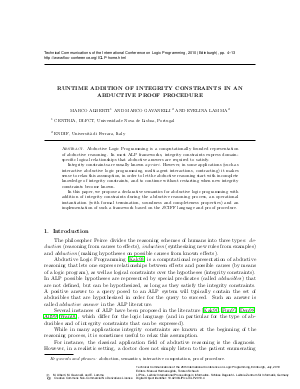Runtime Addition of Integrity Constraints in an Abductive Proof Procedure
Authors Marco Alberti, Marco Gavanelli, Evelina Lamma
-
Part of:
Volume:
Technical Communications of the 26th International Conference on Logic Programming (ICLP 2010)
Part of: Series: Leibniz International Proceedings in Informatics (LIPIcs)
Part of: Conference: International Conference on Logic Programming (ICLP) - License:
 Creative Commons Attribution-NonCommercial-NoDerivs 3.0 Unported license
Creative Commons Attribution-NonCommercial-NoDerivs 3.0 Unported license
- Publication Date: 2010-06-25
File

PDF
LIPIcs.ICLP.2010.4.pdf
- Filesize: 0.55 MB
- 10 pages
Document Identifiers
Subject Classification
Keywords
- Abduction
- semantics
- interactive computation
- proof procedure
Metrics
- Access Statistics
-
Total Accesses (updated on a weekly basis)
0Document
0Metadata
Abstract
Abductive Logic Programming is a computationally founded representation of abductive reasoning. In most ALP frameworks, integrity constraints express domainspecific logical relationships that abductive answers are required to satisfy. Integrity constraints are usually known a priori. However, in some applications (such as interactive abductive logic programming, multi-agent interactions, contracting) it makes sense to relax this assumption, in order to let the abductive reasoning start with incomplete knowledge of integrity constraints, and to continue without restarting when new integrity constraints become known. In this paper, we propose a declarative semantics for abductive logic programming with addition of integrity constraints during the abductive reasoning process, an operational instantiation (with formal termination, soundness and completeness properties) and an implementation of such a framework based on the SCIFF language and proof procedure.
Cite As Get BibTex
Marco Alberti, Marco Gavanelli, and Evelina Lamma. Runtime Addition of Integrity Constraints in an Abductive Proof Procedure. In Technical Communications of the 26th International Conference on Logic Programming. Leibniz International Proceedings in Informatics (LIPIcs), Volume 7, pp. 4-13, Schloss Dagstuhl – Leibniz-Zentrum für Informatik (2010)
https://doi.org/10.4230/LIPIcs.ICLP.2010.4
BibTex
@InProceedings{alberti_et_al:LIPIcs.ICLP.2010.4,
author = {Alberti, Marco and Gavanelli, Marco and Lamma, Evelina},
title = {{Runtime Addition of Integrity Constraints in an Abductive Proof Procedure}},
booktitle = {Technical Communications of the 26th International Conference on Logic Programming},
pages = {4--13},
series = {Leibniz International Proceedings in Informatics (LIPIcs)},
ISBN = {978-3-939897-17-0},
ISSN = {1868-8969},
year = {2010},
volume = {7},
editor = {Hermenegildo, Manuel and Schaub, Torsten},
publisher = {Schloss Dagstuhl -- Leibniz-Zentrum f{\"u}r Informatik},
address = {Dagstuhl, Germany},
URL = {https://drops.dagstuhl.de/entities/document/10.4230/LIPIcs.ICLP.2010.4},
URN = {urn:nbn:de:0030-drops-25784},
doi = {10.4230/LIPIcs.ICLP.2010.4},
annote = {Keywords: Abduction, semantics, interactive computation, proof procedure}
}
